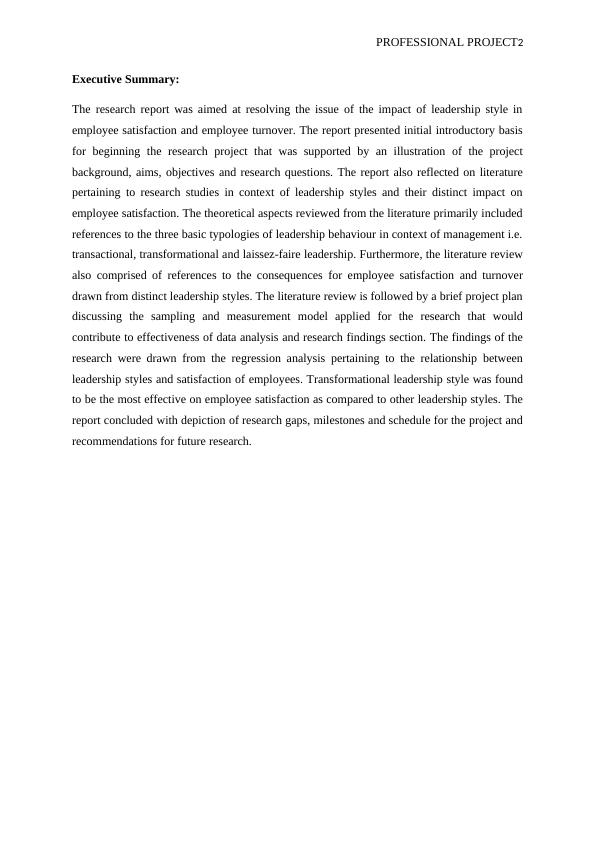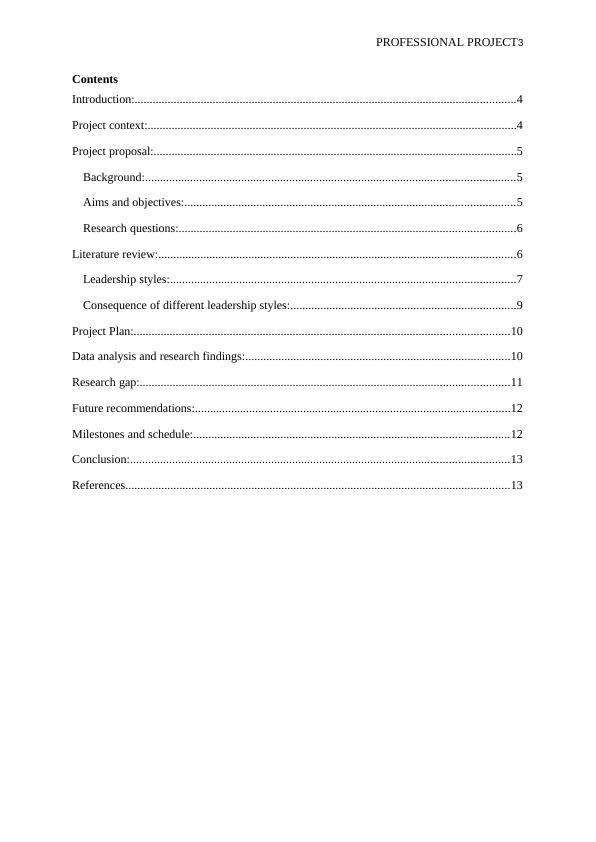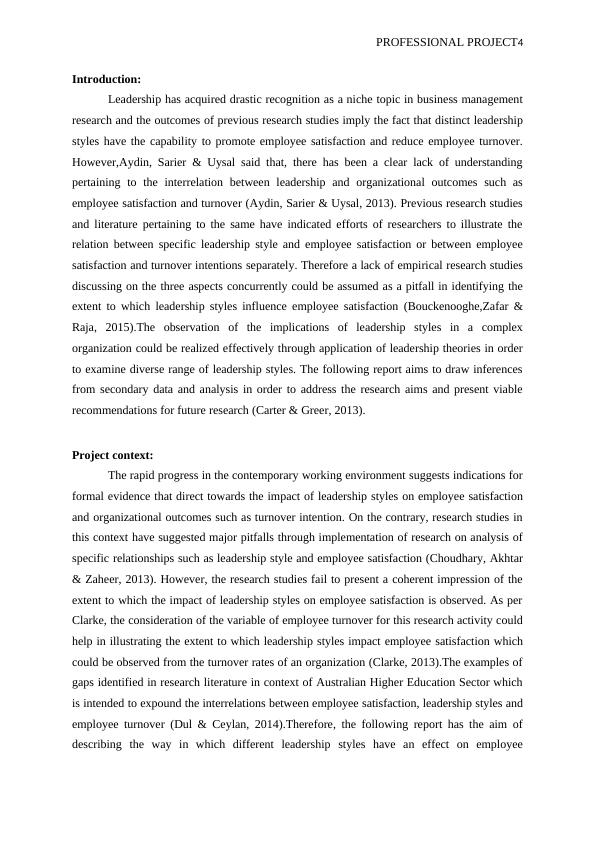The Impact of Leadership Style
17 Pages5309 Words42 Views
Added on 2020-03-16
The Impact of Leadership Style
Added on 2020-03-16
ShareRelated Documents
Running Head: PROFESSIONAL PROJECT1Professional Project<Student ID><Student Name><University Name>

PROFESSIONAL PROJECT2Executive Summary:The research report was aimed at resolving the issue of the impact of leadership style inemployee satisfaction and employee turnover. The report presented initial introductory basisfor beginning the research project that was supported by an illustration of the projectbackground, aims, objectives and research questions. The report also reflected on literaturepertaining to research studies in context of leadership styles and their distinct impact onemployee satisfaction. The theoretical aspects reviewed from the literature primarily includedreferences to the three basic typologies of leadership behaviour in context of management i.e.transactional, transformational and laissez-faire leadership. Furthermore, the literature reviewalso comprised of references to the consequences for employee satisfaction and turnoverdrawn from distinct leadership styles. The literature review is followed by a brief project plandiscussing the sampling and measurement model applied for the research that wouldcontribute to effectiveness of data analysis and research findings section. The findings of theresearch were drawn from the regression analysis pertaining to the relationship betweenleadership styles and satisfaction of employees. Transformational leadership style was foundto be the most effective on employee satisfaction as compared to other leadership styles. Thereport concluded with depiction of research gaps, milestones and schedule for the project andrecommendations for future research.

PROFESSIONAL PROJECT3ContentsIntroduction:...............................................................................................................................4Project context:...........................................................................................................................4Project proposal:.........................................................................................................................5Background:...........................................................................................................................5Aims and objectives:..............................................................................................................5Research questions:................................................................................................................6Literature review:.......................................................................................................................6Leadership styles:...................................................................................................................7Consequence of different leadership styles:...........................................................................9Project Plan:.............................................................................................................................10Data analysis and research findings:........................................................................................10Research gap:...........................................................................................................................11Future recommendations:.........................................................................................................12Milestones and schedule:.........................................................................................................12Conclusion:..............................................................................................................................13References................................................................................................................................13

PROFESSIONAL PROJECT4Introduction:Leadership has acquired drastic recognition as a niche topic in business managementresearch and the outcomes of previous research studies imply the fact that distinct leadershipstyles have the capability to promote employee satisfaction and reduce employee turnover.However,Aydin, Sarier & Uysal said that, there has been a clear lack of understandingpertaining to the interrelation between leadership and organizational outcomes such asemployee satisfaction and turnover (Aydin, Sarier & Uysal, 2013). Previous research studiesand literature pertaining to the same have indicated efforts of researchers to illustrate therelation between specific leadership style and employee satisfaction or between employeesatisfaction and turnover intentions separately. Therefore a lack of empirical research studiesdiscussing on the three aspects concurrently could be assumed as a pitfall in identifying theextent to which leadership styles influence employee satisfaction (Bouckenooghe,Zafar &Raja, 2015).The observation of the implications of leadership styles in a complexorganization could be realized effectively through application of leadership theories in orderto examine diverse range of leadership styles. The following report aims to draw inferencesfrom secondary data and analysis in order to address the research aims and present viablerecommendations for future research (Carter & Greer, 2013). Project context:The rapid progress in the contemporary working environment suggests indications forformal evidence that direct towards the impact of leadership styles on employee satisfactionand organizational outcomes such as turnover intention. On the contrary, research studies inthis context have suggested major pitfalls through implementation of research on analysis ofspecific relationships such as leadership style and employee satisfaction (Choudhary, Akhtar& Zaheer, 2013). However, the research studies fail to present a coherent impression of theextent to which the impact of leadership styles on employee satisfaction is observed. As perClarke, the consideration of the variable of employee turnover for this research activity couldhelp in illustrating the extent to which leadership styles impact employee satisfaction whichcould be observed from the turnover rates of an organization (Clarke, 2013).The examples ofgaps identified in research literature in context of Australian Higher Education Sector whichis intended to expound the interrelations between employee satisfaction, leadership styles andemployee turnover (Dul & Ceylan, 2014).Therefore, the following report has the aim ofdescribing the way in which different leadership styles have an effect on employee

End of preview
Want to access all the pages? Upload your documents or become a member.
Related Documents
Leadership style and its relationship to employee satisfactionlg...
|11
|3005
|46
Market Research and Production Process in Cadbury'slg...
|15
|4657
|325
Employee Motivation, Job Satisfaction and Leadership: A Case Study of Hong Kong Airlineslg...
|12
|2318
|463
Role of Human Resource in Enhancing Employee Satisfaction and Motivationlg...
|12
|2872
|102
Employee Turnover: Causes, Impact, and Solutionslg...
|7
|1304
|250
Impacts of Leadership on Retention of Talented Employees in Retail Sector: A Study on Marks and Spencerslg...
|8
|931
|166
